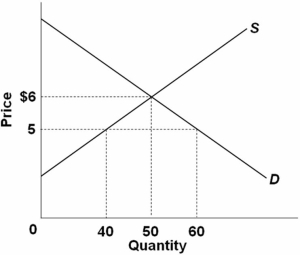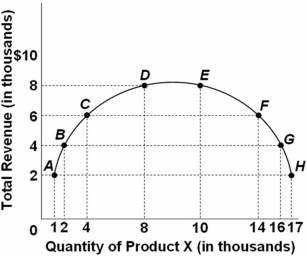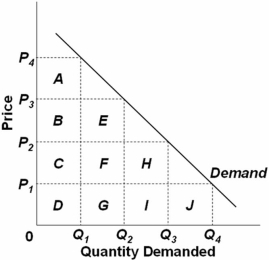A) 0.22
B) 0.40
C) 0.56
D) 1.22
The change in quantity is (400 - 500) /(400 + 500) = 0.111 and the change in price is (2 - 3) /(2 + 3) = 0.20.Thus,elasticity is 0.56.
Correct Answer

verified
Correct Answer
verified
Multiple Choice
An auto rental company lowers the price of its rentals to increase its market share.The price cut increases quantity demanded,but total revenue decreases.This result suggests that over this price range,the demand for the auto rentals is:
A) elastic.
B) inelastic.
C) unit elastic.
D) perfectly elastic.
Correct Answer

verified
Correct Answer
verified
Multiple Choice
 Refer to the table above.Starting at a $5 price,at what price range does demand become inelastic?
Refer to the table above.Starting at a $5 price,at what price range does demand become inelastic?
A) $1-2
B) $2-3
C) $3-4
D) $4-5
At $2-3,the change is (30 - 40) /(30 + 40) = 0.143 and the percent in price is (3 - 2) /(3 + 2) = 0.20.Thus,elasticity is 0.143/0.20 = 0.714,which is inelastic.
Correct Answer

verified
Correct Answer
verified
Multiple Choice
 Refer to the graph above.If the price of the product increases from $5 to $6 because of a decrease in supply that is shown by curve S,total revenue would:
Refer to the graph above.If the price of the product increases from $5 to $6 because of a decrease in supply that is shown by curve S,total revenue would:
A) increase by $300.
B) increase by $100.
C) decrease.
D) stay the same.
Correct Answer

verified
Correct Answer
verified
True/False
If the price of a product increases from $10 to $12 and the quantity demanded decreases from 40 to 30,then according to the total-revenue test,the product is price elastic in this price range.
Correct Answer

verified
Correct Answer
verified
Multiple Choice
If a 10 percent increase in the price of product X causes the demand for product Y to decrease by 15 percent,then:
A) X and Y are substitutes.
B) X and Y are complements.
C) X and Y are independent goods.
D) the demand for X is elastic.
Correct Answer

verified
Correct Answer
verified
Multiple Choice
If the cross-price-elasticity of goods X and Y is positive,then the sales of X move:
A) in the same direction as the price of Y,and X and Y are complementary goods.
B) in the opposite direction as the price of Y,and X and Y are complementary goods.
C) in the opposite direction as the price of Y,and X and Y are substitute goods.
D) in the same direction as the price of Y,and X and Y are substitute goods.
Correct Answer

verified
Correct Answer
verified
Multiple Choice
The price of season tickets to a performing arts theater decreases by 3 percent.As a result,the quantity demanded increases by 6 percent.The price elasticity of demand for season tickets is:
A) 0.
B) 1.
C) 2.
D) 3.
Correct Answer

verified
Correct Answer
verified
Multiple Choice
 Refer to the above graph.At total revenue of $8,000,the price elasticity of demand is:
Refer to the above graph.At total revenue of $8,000,the price elasticity of demand is:
A) elastic.
B) inelastic.
C) unit-elastic.
D) perfectly inelastic.
Correct Answer

verified
Correct Answer
verified
Multiple Choice
If the price elasticity of demand for a good is .75,the demand for the good can be described as:
A) normal.
B) elastic.
C) inferior.
D) inelastic.
Correct Answer

verified
Correct Answer
verified
True/False
Price elasticity of demand is lower for goods with few close substitutes.
Correct Answer

verified
Correct Answer
verified
Multiple Choice
An increase in the price of a good will cause total revenue to fall if price elasticity of demand is:
A) elastic.
B) inelastic.
C) unitary elastic.
D) perfectly elastic.
Correct Answer

verified
Correct Answer
verified
Multiple Choice
Elasticity of supply will increase when:
A) the number of producers selling a product decreases.
B) producers are given less time to respond to price changes.
C) the number of consumers wanting to purchase a product increases.
D) it becomes easier to substitute one factor of production for another in a manufacturing process.
Correct Answer

verified
Correct Answer
verified
Multiple Choice
For complementary goods,the coefficient of cross-price-elasticity of demand is:
A) negative.
B) positive.
C) greater than one.
D) near zero.
Correct Answer

verified
Correct Answer
verified
Multiple Choice
The relationship between a consumer's monthly income and monthly consumption of four products,A-D,is shown below.  Which product listed is an example of an inferior good?
Which product listed is an example of an inferior good?
A) A
B) B
C) C
D) D
Correct Answer

verified
Correct Answer
verified
Multiple Choice
At a price of $20 per unit,140 units of goods are demanded and 100 units are supplied.When the price is raised to $30 per unit,100 units are demanded and 140 units are supplied.The price elasticity of supply in this range is:
A) 1.0.
B) 0.834.
C) 0.417.
D) 1.20.
The change in quantity is (140 - 100) /(140 + 100) = 0.167 and the change in price is (30 - 20) /(30 + 20) = 0.20.Thus,elasticity is 0.167/0.20 = 0.835.
Correct Answer

verified
Correct Answer
verified
Multiple Choice
A study of mass transit systems in American cities revealed that long-run revenues generally decline after substantial fare increases.This suggests that:
A) the demand for mass transit is price-elastic in the long run.
B) the demand for mass transit is price-inelastic in the long run.
C) mass transit service deteriorates in the long run as price rises.
D) there are few good substitutes for such systems in urban areas.
Correct Answer

verified
Correct Answer
verified
Multiple Choice
 Refer to the graph above and assume that the areas of the boxes are the same.Consider a situation where price increases from P3 to P4.In this price range,demand is relatively:
Refer to the graph above and assume that the areas of the boxes are the same.Consider a situation where price increases from P3 to P4.In this price range,demand is relatively:
A) inelastic because the loss in total revenue (areas E + F + G) is greater than the gain in total revenue (area A) .
B) elastic because the loss in total revenue (areas E + F + G) is greater than the gain in total revenue (area A) .
C) elastic because the loss in total revenue (area A) is greater than the gain in total revenue (areas E + F + G) .
D) inelastic because the loss in total revenue (area A) is greater than the gain in total revenue (areas E + F + G) .
Correct Answer

verified
Correct Answer
verified
Multiple Choice
Assume the price of a product rises from $2 to $3 and the quantity demanded of the product decreases from 600 to 400.The price elasticity of demand coefficient,using the midpoint formula,is:
A) 0.40.
B) 1.00.
C) 1.60.
D) 2.10.
The change in quantity is (400 - 600) /(400 + 600) = 0.20 and the change in price is (3 - 2) /(3 + 2) = 0.20.Thus,price elasticity is 0.20/0.20 = 1.0.
Correct Answer

verified
Correct Answer
verified
Multiple Choice
 Refer to the graph above.If demand increased:
Refer to the graph above.If demand increased:
A) price and quantity would increase.
B) price and quantity would decrease.
C) price would stay the same and quantity would decrease.
D) price would stay the same and quantity would increase.
Correct Answer

verified
Correct Answer
verified
Showing 101 - 120 of 144
Related Exams